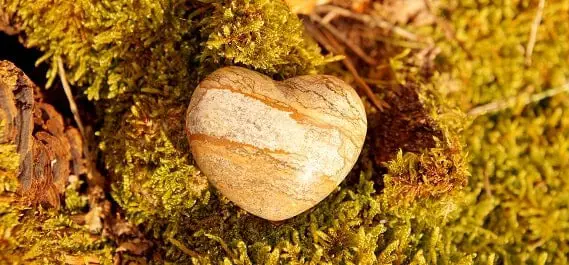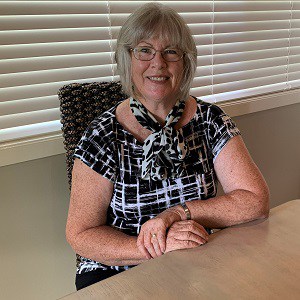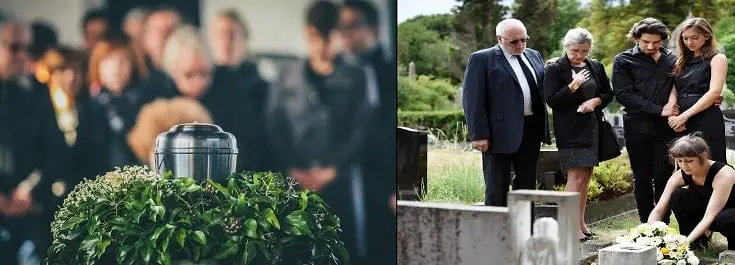The choice between burial and cremation is a highly personal one. Often religious beliefs mixed with ethnic values are the overlying reasons for the choice.
But from a cost and environmentally friendly point of view, cremation is wining in the popularity stakes. This means that cremation is better than burial because:
Cremation is quicker, ‘cheaper, requires less or no land, and you can still have a funeral service and burial afterward if you wish.
The family may keep the ashes at home, or sprinkle the ashes in the deceased person’s favorite area, or you can bury the urn and place a marker on a cremation plot.
A direct cremation is the cheapest option when faced with a funeral. The reason being is that there is no embalming necessary, there is no viewing, no immediate service, so the body doesn’t have to be dressed or made up for the occasion.
The body is wrapped in linen and placed on a cardboard tray for cremation. Therefore cremation forgoes the expensive casket, dressage, and plot of land required with a burial.
Many families keep the ashes in an urn at home or disperse the ashes over water or into a country breeze (local councils permitting).
These factors make a cremation cheaper overall, the service is simpler, and yet a cremation still allows the family to express their farewell to their loved one in a dignified way.
The choice for cremation has risen from 48.6 percent in 2015 and is expected to reach 54.3 in 2021. This statistic is quoted from the Cremation Association of North America (CANA). https://www.cremationassociation.org/page/AboutCANA
The statistics for cremation in preference to burial are therefore rising steadily in its favor.
Cremation is Quicker than Burial.

To put it bluntly, a cremation is almost instant. The fire renders the deceased’s body to ashes with hours.
With a burial, the body can take up to 50 years for the tissues to breakdown and disappear, which leaves behind the mummified skin and tendon. These will eventually disappear after 80 years.
The choice depends on the individual.
Some people prefer the cleansing fire compared to the thought of a long decomposing body in the ground.
Apart from that cold analysis, the process leading up to the action of cremation is quicker.
- The cremation is done within days, any day from the time of death.
- A shorter service is usually held to honor the deceased, and these can be held at the time of cremation or some days or weeks afterward.
- The ashes are given to the family either to bury within a cremation plot or to keep them at home.
- While cremation is respectful, it requires less ceremonial time or additional pomp before the deceased is put to rest.
There is no right or wrong way. It depends on the family, the wishes of the deceased, and how YOU feel about the final ceremonial of a loved one’s life.
It is Less Costly Which Makes Cremation More Affordable.
A cremation has fewer costs for the process, which can be an influencing factor when planning for a funeral.
The savings with a cremation include:
- There is no need to embalm the body, which can save from between $500 – $1,000 or more.
- There is no need for an expensive casket. These savings can run from between $2000 and $15000 or more. If you want a service before the cremation, the funeral home can rent you the use of a nice casket for the service so everyone can pay their respects. This cost is around $1000.
- There is no need to purchase a funeral plot of land for the funeral. You can buy a cremation plot in the cemetery of your choice if you want to. These costs vary widely per town and state, so it pays to check out the location of your preferred cemetery during the planning phase.
- Urns come in a range of prices, from the most elaborate to a simple, elegant urn. It depends on personal choice and where you will house the urn. Some people choose to have the ashes in a simple or decorative small wooden box. These vary in price depending on the material and the design of the box.
- Headstones are not required for cremation, although if you are burying the ashes in a cemetery cremation plot, you can put in a nice cross or small marker for the gravesite. This makesit is a lot less expensive than marble or stone.
- With a direct cremation (when the body is cremated in the days immediately after their passing), there is no viewing and no funeral services beforehand. The family can plan a memorial or a celebration of the deceased’s life on their own time and within their budget.
Cremation Requires Less or No Land.

Cremation doesn’t require the purchase of a large burial plot as a final resting place.
You can opt for a cemetery plot to bury the ashes, as most cemeteries have cremation plots. These plots are small and often are simply decorated with a cross or a rose bush. When all the roses are in bloom, it makes a beautiful place to visit.
The other choice is to have the ashes stored in a beautiful urn or small box of choice and to keep the ashes at home. Some people feel comforted having the ashes at home and feel that they are kept close to the family.
You can also choose to disperse the ashes in a favorite spot or location of the deceased such as the sea, wildlife area, or a river, but you would need to check with authorities whether that is allowed in your area.
Burial plot or throwing the ashes to the wind, the choice is personal. But whatever you choose, you will not have to pay for a large plot as you would have to in a traditional burial.
Choosing cremation will save valuable parcels of land for other urgent requirements such as housing creation for the local people. It will also save many thousands of trees worldwide so that they can be used for other services.
You Can Still Have a Service and Burial of The Ashes with Cremation.
It is quite common for the family of the deceased to have a funeral service either before or after the cremation. If the ashes are to be buried, a graveside ceremony can also be arranged.
- Traditional burial always has the service before internment (being buried), but with cremation, you can have a service at the time of the passing, days after, or even weeks after the body has been cremated.
- The service can be held prior to the cremation, or afterward.
- You can even plan and hold the service yourself as you have the ashes and will only require the a funeral director’s services if you wish to bury the ashes in a cemetery.
- Some families prefer direct cremation, where the body is cremated promptly after death, without a viewing or service. Later they usually hold a personal service for family and friends to celebrate their loved one’s life. This suits families who are flying in from distant locations, which can take time.
- Many prefer to have a service before they disperse the ashes over water, forest, or garden area.
- In this age of the internet, you can even arrange a ‘gathering’ of friends and family online before the laying of the ashes to rest.
The options with cremation are many and varied. The cost can be as much or as little as your budget allows.
Cremation has More Options of Where to Place the Ashes.
When comparing cremation to burial, it is important to note the many options available regarding where the ashes can be placed.
An enquiring mind will open the door to options that you never even knew existed.
Some of these include the following.
- The ashes in the urn can be placed in a special area of the cemetery in a cremation plot or garden. This is a very small area that can have either a small cross, a rose bush, or a similar marker to the plot. These plots are less expensive than the large burial plots.
- A columbarium or cremation niche is a room in a church or cemetery, or it can be a freestanding wall. The urn or box containing the ashes can be placed in a small individual space called niches. (They are like a glorified cupboard that stores ashes instead of documents) A marker identifying the deceased is placed on the outside. The columbarium offers storage for the urn and ashes and is a place of quiet contemplation.
- You can scatter the ashes around private land that you own, but if you want to do it over any land belonging to another owner, you must ask for permission.
- Note that within National Parks, it is typically not allowed for ashes to be scattered. Check with your local authorities if your loved one wants their ashes spread in these areas.
- Burial at sea – this innovative approach for a funeral is perfect for the water-loving deceased. The ocean or rivers make a beautiful location to scatter the ashes or release the urn to the depts. Requirements state that you need to travel at least 3 nautical miles from the low water line and use a biodegradable urn. If you want to bury the cremains closer to the shore, you will need to check with local bylaws or officials.
- Another creative way is to mix the ashes of the loved one in the soil of a small growing tree then plant it to have a beautiful natural plant marking their passing.
- Turn ashes into artwork with glass orbs, stained glass, or even resin.
- Cremation Diamonds are made from the ashes. These are beautifully stunning gems that are quite costly and mimics the way the earth creates natural diamonds. They can be integrated with most types of jewelry sets.
- Or you can simply decide to keep the ashes at your home, protected by a beautiful urn and close to the hub of family life.
Environmental Impact from a Funeral

There is no doubt that burial and cremation both have a degree of harmful impact on the environment.
But when you check the facts, a lot of detrimental effects depend on how you bury or cremate the body.
- Have you ever wondered how cemeteries remain so green and lush? No, it’s not what you think (as in the bodies within the ground), but it takes a ton of water, pesticides, and fertilizers to keep it that way.
- Embalming a body is a toxic process. Many chemicals including Formaldehyde is lethal in high amounts. It may preserve the body for longer, but it lingers in the soil.
- It is estimated that 800,000 gallons of formaldehyde alone are put into the ground each year from traditional burials.
- Traditional burial also uses hardwood, copper and bronze, steel, and reinforced concrete, all of which will contaminate the ground.
- Large swathes of forests are used for building caskets for burials. These valuable timbers could be used for housing the nation’s population.
- The trend seems to be for an elegant yet eco-friendly funeral, which combines for the purpose of farewelling a loved one with saving the planet.
But what about cremation? It does have an effect on the environment, albeit much less than a traditional burial.
- Using fire to turn a body into ashes does release toxic chemicals into the air.
- These chemicals include carbon monoxide, sulfur dioxide, fine soot, and most concerning of all is mercury emissions.
The Greenest Methods
1. A Green or Natural Burial.
Replacing the traditional burial with a green burial is becoming very popular, and they are more eco friendly than either traditional burial or cremation.
They do not use any products or practices that will harm the environment. The body is buried in a biodegradable casket without using embalming at all.
The purpose is to provide a burial that doesn’t disturb the rhythm of nature and seeks to allow nature to go its own way.
2. Water Cremation.
This method uses water, not flame, to cremate the body. The process uses water and potassium hydroxide mixed with the body and heated to 350F. This process has been around for some years but is gaining popularity now.
I had never heard of this option before, so I was intrigued to find that instead of fire, water, albeit pretty hot water, could be used. This may be an option for those who find the thought of a fire scary, yet like the ethics of cremation.
The resulting ashes are whiter in color. The only downside is that this practice is not available everywhere.
The Last Word
I am sure you agree that there are more options with cremation than traditional burial, and while it does affect the environment, its footprint is a lot smaller.
As the world advances, so too will we find new and more natural ways to put our loved ones who have passed away into their final resting place.
As I have said often in this article, there is no right or wrong way; it is what feels best for the loved ones left behind and/or the instructions the deceased may leave as to their last wishes.
If the funeral was unexpected, it can be a tough time having to choose which one to do.
Do your homework, check out all the options, but the decision should be yours, and it should be based on what the deceased wishes.
Anytime is a tough time to plan a funeral, but it is even harder when the funeral was unexpected. I hope this guide has helped you compare your options for funeral considerations.

Sources.
https://cremationinstitute.com/cremation-vs-burial/
https://www.learnreligions.com/what-does-the-bible-say-about-cremation-700373
https://www.greencremationtexas.com/cremation-vs-burial/
https://www.greencremationtexas.com/cremation-services/water-cremation/
https://www.perfectmemorials.com/guides/options-for-burying-ashes-after-cremation/
https://cremationinstitute.com/cremation-ceremony/
https://www.funeralbasics.org/cremation-importance-ceremony/
https://www.funeraldirect.co/how-to-dispose-of-human-ashes/
https://www.perfectmemorials.com/guides/how-does-cremation-work-and-other-quick-cremation-facts/
https://www.cremationassociation.org/page/AboutCANA
https://resources.tulipcremation.com/2018/10/22/all-posts/cremation-vs-burial/
https://www.thelivingurn.com/pages/product
https://www.healthline.com/health-news/water-cremation-becoming-popular#How-water-cremation-works

